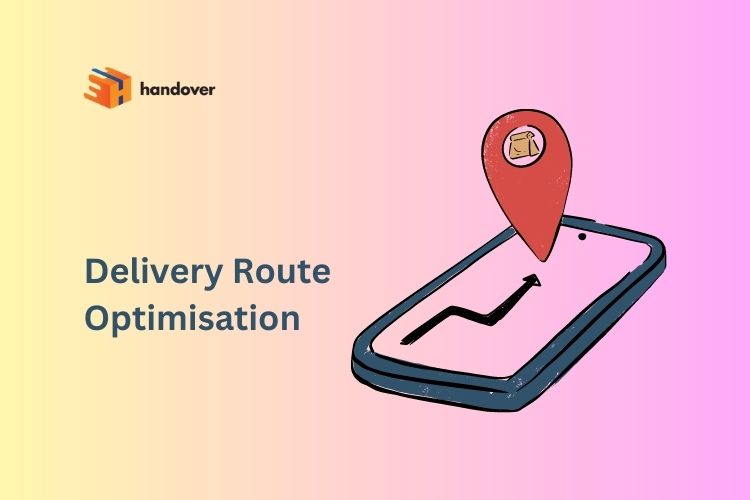Handover news
Blog
Delivery Route Optimisation Holds the Key to Customer Satisfaction

The emergence of same-day delivery or dark store concept has made delivery route optimisation important for delivery partners. Nowadays, delivery partners have been using route optimisation tools to reduce delivery time. So, they must plan routes effectively to deliver to customers on time.
Route optimisation comes with several benefits such as boosting delivery productivity, reducing delivery costs and enhancing customers’ experience. Therefore, as retailers, if you want to reduce delivery cost and increase sales, consider collaborating with handover.
What is Delivery Route Optimisation?
Route optimisation is the process of choosing the best possible delivery routes to reach from point A to point B as quickly and cost effectively as possible. Various factors concerning route optimisation help delivery partners deliver orders efficiently to customers. These include driver schedules, available hours, total stops, fulfilment estimates, and legal requirements. However, finding the fastest or cheapest route is not the only objective of route optimisation. It’s also about effectively solving delivery issues for customers.
Why is Route Optimisation Important?
Route optimisation helps reduce costs, increase efficiency, improve customer service, and ensure greater flexibility and control.
Reduces Cost
Route optimisation helps decrease the number of vehicles required for delivery and the cost of labour and fuel. Because it assists in determining the time and resources for delivery by ensuring the most efficient and economical routes. All that eventually increases profits and reduces cost.
Increases Efficiency
Route optimisation tools can ensure the most effective delivery routes, decrease travel time and increase delivery speed using sophisticated algorithms and data analysis. Thus, route optimisation assists businesses in expanding their delivery operation. It makes the delivery process smooth and increases overall delivery operations.
Improves Customers’ Experiences
Route optimisation ensures that customers quickly receive their orders. And this process can help businesses in return by ensuring enhanced customer loyalty towards them. That loyalty will likely translate into more sales for business enterprises. Besides, it helps avoid common delivery mistakes like missing or delayed goods, which could disrepute the brand and reduce customer confidence in businesses.
Greater Flexibility and Control
As business owners, you can track orders in real-time, know delivery updates and the exact location of your delivery executive by using route optimisation tools. It can also help you deliver to your customers on time.
How is Delivery Route Optimisation Better than Traditional Route Planning Technique?
Route optimisation is the latest concept in the delivery system. But it can help businesses determine their efficient delivery route and avoid the problems and challenges that might occur with traditional route-planning techniques.
Real-time Tracking
In traditional delivery methods, you could not access the real-time tracking and road traffic conditions. But route optimisation enables you to have real-time tracking and road traffic conditions. For example, if there is traffic blockage 1 KM ahead, your route optimisation will likely signal you to take some other path and avoid the traffic blockage.Thus, real-time tracking and route optimisation analytics help logistics companies save transportation costs and ensure on-time deliveries. It enhances not only revenues but also customer satisfaction.
Delivery Productivity
Nowadays, customers expect their deliveries on time. So, businesses remain under pressure to satisfy their respective customers. To solve these problems, businesses have started using route optimisation. It enables them to deliver the products on time. Further, it helps maximise the number of drops and pickups, allowing the drivers to attempt more deliveries in less time than traditional route planning techniques.
Ground Level Visibility
Route optimisation offers real-time tracking, on-the-ground visibility of all resource movements. This increases the possibility for higher revenues by enabling better logistical and operational processes control. Meanwhile, traditional route-planning techniques do not guarantee these facilities. So, businesses are rooting for route optimisation.
Boosts Customer Experience
There is a lot of competition within the logistics industry because customers are ready to switch to another company if one company fails to meet their expectations. Route optimisation can allow you to keep your customers loyal to your business and helps you improve customer experiences by providing exact delivery time and pre-announced time slots for deliveries.
On the contrary, traditional route-planning techniques lack a real-time tracking system that makes customers dissatisfied with the services.
Conclusion
Nowadays, customers know no loyalty unless they get services as per their expectations. Businesses have thus started using route optimisation to meet such needs and boost sales. handover, a one-of-a-kind delivery channel, has been helping businesses with route optimisation and other techniques.
